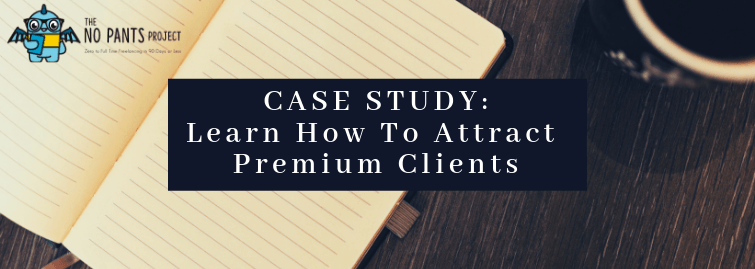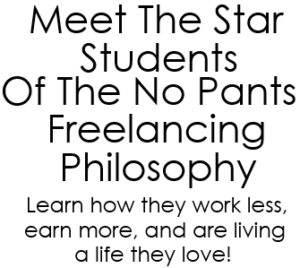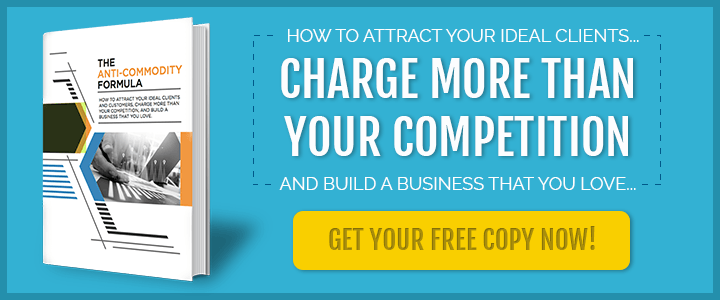You started (or want to start) your freelancing business because you want to do what you love.
You want to follow your passion.
You want to get paid what you’re worth.
To do that, you’re gonna need to get over yourself.
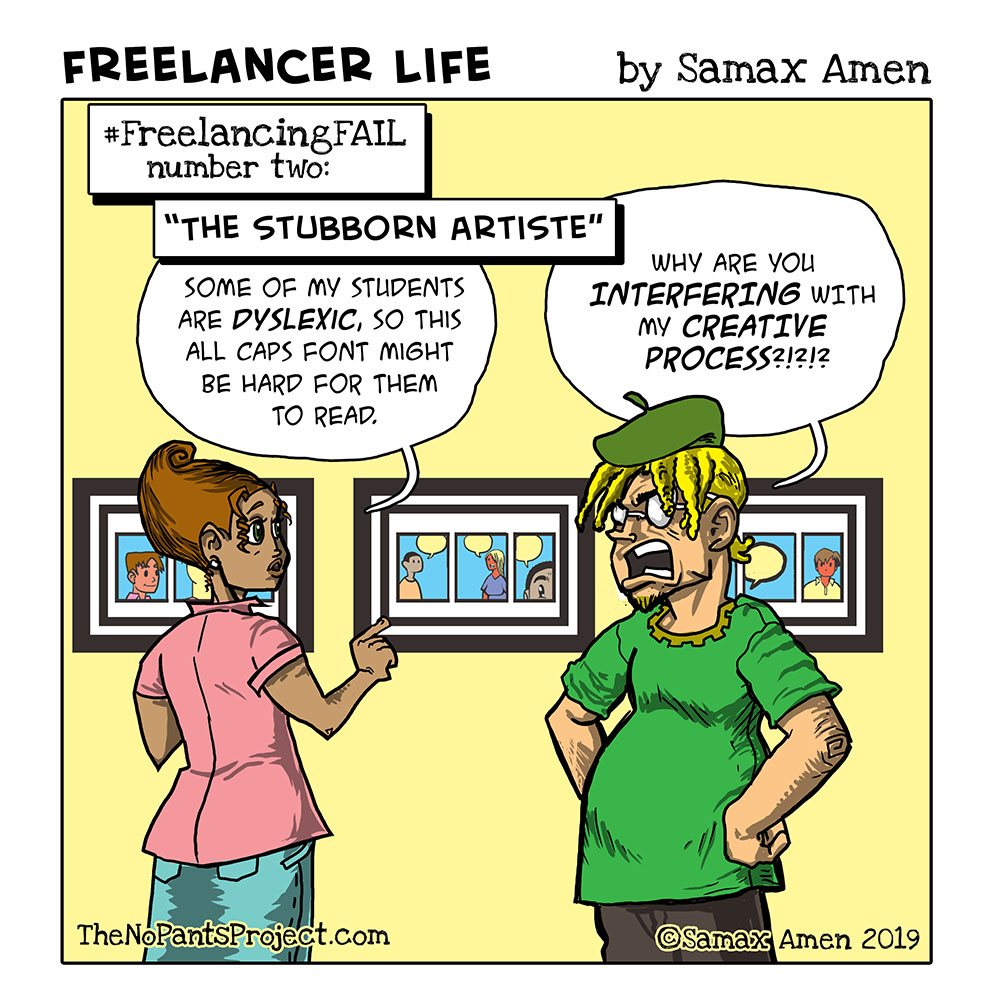
“People don’t care how much you know until they know how much you care.” -Theodore Roosevelt
Your freelancing business isn’t just about you.
Being good at what you do and doing something you enjoy are important, sure.
But your clients and customers will be the source of your income.
Honestly… Why should your client care about your passion for classic movie posters or Beatles b-sides?
Bill Cates, author of three popular books on getting referrals, says: “You must go beyond what makes you different. What makes you relevant?”
How does what you do, the way you do it, the difference between you and others help your potential client?
What’s the benefit to them of choosing your product or service?
Empathy (the ability to understand and share the feelings of another) will allow you to answer these questions better than your competitors, because most freelancers are so focused on what they want that they don’t think enough about what their customers want.
Brian Patrick Eha’s article on Entrepreneur.com quotes master motivator Zig Ziglar who famously said:
“You can have everything in life you want, if you will just help enough other people get what they want.”
Mike Shreeve (Head Troublemaker here at The No Pants Project) is always reminding us of this quote, because empathy is one the core principles of successful freelancing.
Develop your ability to empathize with the prospects and clients in your chosen niche, and you will rise above the majority of your competition.
So let’s explore the power of empathy, and learn how to apply it in your business.
If you apply empathy correctly, everything about getting clients who pay you what you’re worth will get easier.
What Empathy is (and is not)
If our friends at Wikipedia can be believed, “empathy is the capacity to understand or feel what another person is experiencing from within their frame of reference, that is, the capacity to place oneself in another’s position.”
Before we dive into what this means for your business, let’s talk about what empathy is not.
- Empathy is not self-sacrifice. No one is asking you to throw yourself on the altar of your clients’ needs. Always remember that you are not an employee. You are an independent business (with your own concerns and goals) that makes money by helping others. So remember to take care of your most important asset: You!
- Empathy is not pity. The people you want to serve are smart, resourceful, awesome people. They have no use for your pity. Showing pity for your client will likely turn them off, because no one wants to feel pitiful.
- Empathy is not a one-way street. This is not about throwing your energy into a hole, never to return. The idea is to create relationships where you and your client know, like, and trust each other.
- Empathy is not bad for business. In fact, the better you get at understanding your clients’ experiences and caring about their pain, the better you will be at creating relevant products and services that bring in the revenue.
Empathy in Action
Olson’s Chief Creative Officer Kevin McKeon reminds us, “Empathy isn’t what you feel. It’s what you do… Use empathy to power action.”
In this interview with a student, McKeon tells a story about Delta Airlines bringing pizzas to passengers who are stranded on a delayed flight.
“They’re a brand that acts on empathy and doesn’t just bake it into their advertising,” he says. “They understand what you’re going through. That’s one of the reasons I like flying Delta.”
Compare that story to the well-publicized uproar that ensued when United Airlines physically dragged a passenger from an overbooked flight in 2017.
The airline that invited travelers to “Fly the Friendly Skies” had to weather some stormy ones.
The nature of the airline industry may have insulated United from much permanent financial consequences, but your freelancing business probably wouldn’t be so lucky.
My favorite fast food burger chain is Whataburger, which people who don’t live in Texas or the surrounding areas may have never heard of.
The service is always great.
Instead of making me stand to the side and wait for my order, I can take a number and sit at a table or booth for my food to be brought out to me.
The employees are typically nicer, and more polite than those at their competitors.
They periodically walk the floor with napkins and condiments.
They smile a lot.
To be honest, I don’t know if the food at Whataburger is any better for me than McDonalds or any other fast food joint.
But I always prefer to eat there, because they do more to make me feel welcome.
This does not happen by accident.
Someone in the company has designed their policies and procedures with empathy for their customers because they know it will give them a competitive advantage.
The iconic American Camera company Kodak was once so ubiquitous that “having a Kodak moment” meant that something is happening that must be recorded for re-living in the future. At least it used to.
Kodak actually developed their first digital camera in 1975, and produced Apple’s Quicktake Digital Camera in 1994, but their leadership lacked the customer-facing empathy, as well as the humility and insight to accept industry shifts and prepare for competition.
While it rose to dominate the domestic digital camera market in 2005, the digital camera had become a commodity, and its film camera business was contracting rapidly.
With each digital camera sold losing $60 for the company, and its film camera game all but shuttered, it seemed like every gamble Kodak made was a losing one.
One Chapter 11 bankruptcy and over 27,000 lost jobs later, the once mighty Kodak company (now a technology company relegated to business imaging) lives to tell the cautionary tale of failing to understand the shifting needs of your customers.
Companies of all sizes who ignore this lesson do so at their own peril.
“Enlightened companies are increasingly aware that delivering empathy is a powerful tool for improving profits…,” says Belinda Parmar, award winning consultant and founder of The Empathy Business.
In this article for the Harvard Business Review, Parmer reported that the “top 10 companies in her firm’s Global Empathy Index 2015 increased in value more than twice as much as the bottom 10, and generated 50% more earnings.”
Parmer observes, “In our work with clients, we have found a correlation as high as 80% between departments with higher empathy and those with high performers.”
These statements about the importance of empathy for corporations and restaurant chains are just as true for freelancers like you. Maybe more so.
Now you can benefit from the research. But how do you do it?
Let’s think about it.
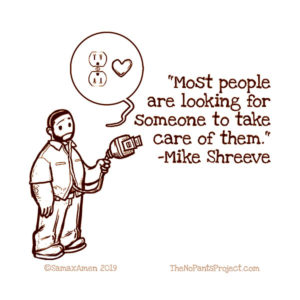
Here’s How You Use Empathy in Your Business
- Define and Find your DREAM CLIENT/CUSTOMER.
“Figure out who you can help, how you can help them, and what that looks like,” says Mike Shreeve in The Anti-Commodity Formula Workbook.
He smiles at how obvious it is, but adds, “I would venture to guess than 85% of all businesses in operation right now have never sat down and actually gone through the process of figuring it out.”
That means you will beat the brakes off your competitors if you put the work in!
- Figure out where your dream clients are, and offer to help them using the methods outlined here.
When composing content for your prospects and customers, ask yourself, “What are the biggest frustrations they might have? What can I teach them to help them overcome that?”
The Law of Reciprocity
In this video, Mike reminds his students to “make the assumption that the prospect is there to be helped.”
Then convince them that you can help them by helping them first, before making any attempt to sell them anything.
Helping your prospects first makes it more likely that they will return the favor in some way.
This is called the Law of Reciprocity. We all have been raised with some version of “Do unto others as you would have them do unto you,” so it isn’t too risky to assume that many of the people you help will be willing to give back to you, in the form of sales.
Of course, some won’t.
That’s why you need to cultivate Outcome Independence by using a system you trust to help as many people as you can.
Make sure you know that if this conversation doesn’t work out … or in other words, they don’t reciprocate by giving you the sale, you can have another opportunity whenever you want.
Remember, you are ultimately looking for Dream Clients.
Clients who can afford to pay you, and who are just the right fit for you.
Values-Based Selling
Not to be confused with Value (no “s”)-Based Selling.
This isn’t about value — the regard that something is held to deserve; the importance, worth, or usefulness of something.
This is about values — a person’s principles or standards of behavior; one’s judgment of what is important in life.
Matching values with premium clients via Values-Based Selling is what it’s all about.
Serving full-scale empathy to the wrong clients can be a nightmare, so you want to take the time to find and cultivate relationships with the right ones.
Here are some things the premium clients are looking for:
- Authenticity: Remember when I implied that no one cares about your love of movie posters or Beatles b-sides? Forget I said that. Authenticity is all about being yourself. When your weird eccentricities and niche interests line up with the client, they become a Dream Client, and your talents become super-powers! Be yourself, and don’t hide your brilliance (yes, I’m talking to you, introverts)!
- Credibility: Be able to do what you say you can do. Show relevant testimonials. Never make a promise you can’t keep. Never, ever make excuses.
- Consistency: Keep your mood swings and flights of fancy to yourself. Keep a good attitude, work ethic, and frequency of communication.
- Doctor Diagnosis: Apply your knowledge and expertise to the client’s business. Make miracles happen like Rod Tidwell.
- Solid on Purchase: Clients love clarity. They love to hear: “Don’t worry about it anymore. I got this.” They love it when your onboarding process is efficient and clean. (Note to self: fix your onboarding process). Clients love to say, “This person has their stuff together.”
This list barely scratches the surface of the video you’ll find at this link. It’s a 2.5 hour video, but I think most of what you need is in the first 90 minutes. Yes, that’s still pretty long, but you will get a serious education in freelancing that is totally worth it!
Speaking of a free educational resource that is worth the time investment, do yourself a solid and download The Anti-Commodity Formula Workbook that I mentioned earlier.
These two resources alone will make you a cosmic grand champion of empathy!
And, if you crave even more training and coaching in six-figure freelancing visit TheNoPantsProject.com!


